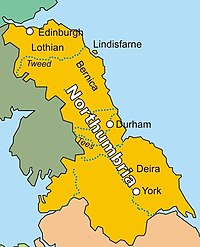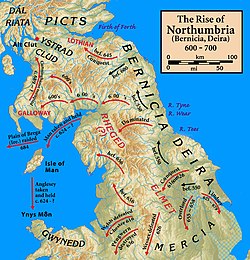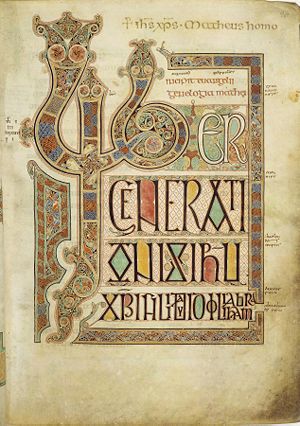Northumbria: Difference between revisions
SloppyDogs (talk | contribs) |
SloppyDogs (talk | contribs) Wearside is in north Durham not south Durham |
||
| Line 63: | Line 63: | ||
Apart from standard English, Northumbria has a series of closely related but distinctive dialects, descended from the version of Old English spoken in ancient Northumbria, with heavy Norse influence.<ref>[http://www.northeastengland.talktalk.net/GeordieOrigins.htm North East dialect origins and the meaning of 'Geordie']</ref> The Scots language derives from Northumbrian English not that of southern Britain, though it was known as ''Ynglis'' or ''Ynglissch'' (or similar spellings) as late as the early 18th century. There are many similarities between [[Modern Scots]] dialects and those of Northumbria. | Apart from standard English, Northumbria has a series of closely related but distinctive dialects, descended from the version of Old English spoken in ancient Northumbria, with heavy Norse influence.<ref>[http://www.northeastengland.talktalk.net/GeordieOrigins.htm North East dialect origins and the meaning of 'Geordie']</ref> The Scots language derives from Northumbrian English not that of southern Britain, though it was known as ''Ynglis'' or ''Ynglissch'' (or similar spellings) as late as the early 18th century. There are many similarities between [[Modern Scots]] dialects and those of Northumbria. | ||
The major Northumbrian dialects today are Geordie (Tyneside), Northern (north of the [[River Coquet]]), Western (from [[Allendale, Northumberland|Allendale]] through [[Hexham]] up to [[Kielder]]), Southern or Pitmatic (the mining towns such as [[Ashington]] and much of [[County Durham|Durham]]),<ref>[http://www.northumbriana.org.uk/langsoc/about.htm The Northumbrian Language Society]</ref> Mackem (Wearside) and Smoggie (Teesside). To an outsider's ear the similarities far outweigh the differences between the dialects. As an example of the difference in the softer | The major Northumbrian dialects today are Geordie (Tyneside), Northern (north of the [[River Coquet]]), Western (from [[Allendale, Northumberland|Allendale]] through [[Hexham]] up to [[Kielder]]), Southern or Pitmatic (the mining towns such as [[Ashington]] and much of [[County Durham|Durham]]),<ref>[http://www.northumbriana.org.uk/langsoc/about.htm The Northumbrian Language Society]</ref> Mackem (Wearside) and Smoggie (Teesside). To an outsider's ear the similarities far outweigh the differences between the dialects. As an example of the difference in the softer Wearside dialect the English 'book' is pronounced 'bewk', in Geordie it becomes 'bouk' while in rural Northumberland it is 'byuk'. | ||
==Legacy== | ==Legacy== | ||
Latest revision as of 04:57, 29 April 2020

Northumbria was a mediæval English kingdom which stretched from the Firth of Forth in the north to the Humber in the south and occasionally included Lindsey. It was known in Old English as Norþhymbra rice, meaning Kingdom of the Northumbrians, The name Norþanhymbre reflects the position of the people, north of the Humber. Northumbria was for a time the most powerful of the English kingdoms, its kings ruling as overlords of all the English kingdoms and of all North Britain.
Northumbria was formed at the beginning of the 7th century by King Æthelfrith by the union of two neighbouring English kingdoms, Bernicia and Deira. At its greatest extent, the kingdom extended at least from just south of the Humber, to the River Mersey and to the Firth of Forth, and there is some evidence that it may have been much greater. The influence of the kings was certainly wider.
The later (and smaller) earldom came about when the southern part of Northumbria, Lancashire and Yorkshire as they are today, was lost to the Norse The northern part, north of the River Tees at first retained its status as a kingdom but when it became subordinate to the Danish kingdom it had its powers curtailed to that of an earldom, and retained that status when England was reunited under the House of Wessex. The earldom was bounded by the River Tees in the south and the River Forth in the north, though later curtailed by the cession of the lands north of the River Tweed.
Much of this land was "debated" between England and Scotland, but the Earldom of Northumbria was eventually recognised as part of England by the Treaty of York in 1237.
Name
The name 'Northumbria' is a Latinised version of the English 'Northumberland', which is from the Old English Norþhymbraland; "Land of the Northhymbre people". The Norþhymbre or earlier Norþanhymbre were so named from their living north of the Humber. In the earliest English sources the kingdom is named Norþanhymbra rice, meaning "Kingdom of the Northhymbre". That form of the name falls out of usage as the kingdom disappeared.
Even after the Norse seized the north, the Anglo-Saxon Chronicle considered the land to be Northumbria, and Manchester is described as belong to it in the record for 919: Miercna þeode . . . sæt gefaran Mameceaster on Norþhymbrum; "The Mercians took Manchester amongst the Northumbrians"[1]
Today the name survives in that of the county of Northumberland. And the name 'Northumbria' is sometimes used as a synonym for North East England as a whole, including County Durham.[2] [3]
Kingdom (604–954)
Northumbria was originally composed of the union of two separate kingdoms, Bernicia and Deira. The people of Bernicia (Beornice) covered lands north of the Tees, while those of Deira (Dere) corresponded roughly to modern-day Yorkshire. These two were first united by King Aethelfrith, a King of the Bernicians who conquered Deira around the year 604. He in turn was defeated and slain around the year 616 in battle at the River Idle by Raedwald of East Anglia, who installed as king Edwin, the son of Ælla, a former King of Deirans.
In the autumn of 616 or 626, King Edwin conquered Elmet, which had survived as a remnant Welsh kingdom of in the Pennines. Edwin accepted Christianity in 627 and soon grew to become the most powerful king in England: he was recognised as Bretwalda and conquered the Isle of Man and Gwynedd in northern Wales. He was, however, himself defeated by an alliance of the exiled king of Gwynedd, Cadwallon ap Cadfan and Penda, King of the Mercians, at the Battle of Hatfield Chase in 633.
King Oswald

After Edwin's death, Northumbria was split between Bernicia, where Eanfrith son of Aethelfrith took power, and Deira, where Osric a cousin of Edwin became king. Both of these rulers were killed during the year that followed, as Cadwallon continued his bloody devastation of Northumbria. After the murder of Eanfrith, his brother Oswald, backed by warriors sent by Domnall Brecc of Dalriada, defeated and killed Cadwallon at the Battle of Heavenfield in 634.
Oswald expanded his kingdom considerably. He consolidated his borders on the Forth, and seems to have incorporated lands as far as Galloway, encroaching on the remaining British-speaking lands, of which Strathclyde remained. King Oswald re-introduced Christianity to the kingdom and appointed St Aidan, an Irish monk from the island of Iona to convert his people. This led to the introduction of the practices of Celtic Christianity. A monastery was established on Lindisfarne.
War with Mercia continued, however. In 642, Oswald was killed by the Mercians under Penda at the Battle of Maserfield. In 655, Penda launched a massive invasion of Northumbria, aided by the sub-king of Deira, Aethelwald, but suffered a crushing defeat at the hands of an inferior force under King Oswiu, Oswald's successor, at the Battle of Winwaed. This battle marked a major turning point in Northumbrian fortunes: Penda died in the battle, and Oswiu gained supremacy over Mercia, making himself the most powerful king amongst the English.
Zenith, decline and conquest
In the year 664 the Synod of Whitby was held to discuss the controversy regarding the timing of the Easter festival. Much dispute had arisen between the practices of the Celtic church in Northumbria and the beliefs of the Roman church. Eventually, Northumbria was persuaded to move to the Roman practice and the Celtic Bishop Colman of Lindisfarne returned to Iona.
Northumbria lost control of Mercia in the late 650s, after a successful revolt under Penda's son Wulfhere, but it retained its dominant position over all the lands of north Britain. However the Northumbrians suffered a disastrous defeat at the hands of the Picts at the Battle of Dun Nechtain in 685; Northumbria's king, Ecgfrith (son of Oswiu), fell in the battle, and its power in the north was broken. The peaceful reign of Aldfrith, Ecgfrith's half-brother and successor, did something to limit the damage done, but it is from this point that Northumbria's power began to decline, and chronic instability followed Aldfrith's death in 704. For the next century and a half, the kingdom was riven by intrigue and civil war and kingship became a dangerous and brief position.

In 867 the Norse descended upon Northumbria and York fell to the brothers Halfdan Ragnarsson and Ivar the Boneless. Initially they installed Ecgberht, as a puppet king, who ruled six years,[4] After his death in 872, Norse kings ruled. At the fringes of the kingdom though, local lords resisted; detail is unknown, but there a King Ricsige is known, who ruled perhaps in just the northern remnant of Northumbria from 872 or 873 to 876, after King Ecgberht I had been driven out. In 900 or thereabouts, the Norse appointed another English king, Æthelwold of Wessex, son of Æthelred I of Wessex; Æthelwold died in battle the next year trying to claim the West Saxon throne.
After the brutal pillaging of the kingdom, the invaders settled and farmed the land. Norwegian rule brought lucrative trade to Northumbria, especially at their capital York. The Norse were cast out at last by King Athelstan, who became the first ruler of all England.
After Athelstan's death the Dublin Norse returned on occasion and four further Norse kings reigned in York, each with an unquiet reign of just a year or two, until finally King Eadred expelled the last of them in 954; Erik Bloodaxe, who had formerly been King of Norway. Erik died in battle without even regaining his crown.
Earldoms in Northumbria (954–1217)
At some time after the English regained the territory of the Northumbrians, Lothian, the land north of the River Tweed was ceded to the King of Scots, though it is not known when this happened: an early source attribute this to a gift by King Edgar and others put it as late as the Battle of Carham in 1018, though no contemporary record suggests a link with the battle. Yorkshire and Northumberland were first mentioned as separate in the Anglo-Saxon Chronicle in 1065.[5]
Norman invasion and partition of the earldom
William the Conqueror became King of the English in 1066. He realised he needed to control Northumbria, which had remained virtually independent of the Kings of England, to protect his kingdom from Scottish invasion. In 1067, William appointed Copsi (or Copsig) as Earl. However, just five weeks into his reign as earl, Copsi was murdered by Osulf II of Bamburgh.
Malcolm III King of the Scots, himself a descendant of the Northumbrian Earls and husband of a Wessex princess, sought to conquer Northumbria to the Tyne, but was repulsed and swore allegiance to the Conqueror.
To acknowledge the remote independence of Northumbria and ensure England was properly defended from the Scots, William gained the allegiance of both the Bishop of Durham and the Earl and confirmed their powers and privileges. However, anti-Norman rebellions followed. William therefore attempted to install Robert Comine, a Norman noble, as the Earl of Northumbria, but before Comine could take up office, he and his 700 men were massacred in the city of Durham. In revenge, the Conqueror led his army in a bloody raid into Northumbria, an event that became known as the Harrying of the North. Ethelwin, the English Bishop of Durham, tried to flee Northumbria at the time of the raid, with Northumbrian treasures. The bishop was subsequently caught, imprisoned, and later died in confinement; his seat was left vacant.
Rebellions continued, and William's son William Rufus decided to partition Northumbria. William of St Carilef was made Bishop of Durham, and was also given the powers of Earl for the region south of the rivers Tyne and Derwent, which became the County Palatine of Durham.
The remainder, to the north of the rivers, became Northumberland, where the political powers of the Bishops of Durham were limited to only certain districts, and the earls continued to rule as clients of the English throne. The town of Newcastle was founded by the Normans in 1080 to control the region by holding the strategically important crossing point of the river Tyne.
Culture

Northumbria during its "golden age" was the most important centre of religious learning and arts in the British Isles. Initially the kingdom was evangelised by Irish monks whose centre was Iona in the Inner Hebrides, and this led to a flowering of monastic life. Lindisfarne on the east coast was founded from Iona by St Aidan in about 635, and was to remain the major Northumbrian monastic centre, producing figures like Wilfrid and Snt Cuthbert. The nobleman Benedict Biscop had visited Rome and headed the monastery at Canterbury in Kent and his twin-foundation Monkwearmouth-Jarrow Abbey added a direct Roman influence to Northumbrian culture, and produced figures such as Ceolfrith and Bede. Northumbria played an important role in the formation of Insular art, a unique style combining Anglo-Saxon, Celtic, Pictish, Byzantine and other elements, producing works such as the Lindisfarne Gospels, St Cuthbert Gospel, the Ruthwell Cross and Bewcastle Cross, and later the Book of Kells, which was probably created at Iona.
After the Synod of Whitby in 664 Roman church practices officially replaced the Celtic ones but the influence of the Celtic style continued, the most famous examples of this being the Lindisfarne Gospels. The Venerable Bede (673–735) wrote his Historia ecclesiastica gentis Anglorum (Ecclesiastical History of the English People, completed in 731) in Monkwearmouth-Jarrow, and much of it focuses on the kingdom.[6] The devastating Viking raid on Lindisfarne in 793 marked the beginning of a century of Viking invasions that severely checked all Anglo-Saxon culture, and heralded the end of Northumbria's position as a centre of influence, although in the years immediately following confident works like the Easby Cross were still being produced.
Language
Apart from standard English, Northumbria has a series of closely related but distinctive dialects, descended from the version of Old English spoken in ancient Northumbria, with heavy Norse influence.[7] The Scots language derives from Northumbrian English not that of southern Britain, though it was known as Ynglis or Ynglissch (or similar spellings) as late as the early 18th century. There are many similarities between Modern Scots dialects and those of Northumbria.
The major Northumbrian dialects today are Geordie (Tyneside), Northern (north of the River Coquet), Western (from Allendale through Hexham up to Kielder), Southern or Pitmatic (the mining towns such as Ashington and much of Durham),[8] Mackem (Wearside) and Smoggie (Teesside). To an outsider's ear the similarities far outweigh the differences between the dialects. As an example of the difference in the softer Wearside dialect the English 'book' is pronounced 'bewk', in Geordie it becomes 'bouk' while in rural Northumberland it is 'byuk'.
Legacy
Today, the term "Northumbria" usually refers to a smaller region corresponding to the counties of Northumberland and County Durham. For instance, the term is used in the names of several North East regional institutions, particularly the police force (Northumbria Police, which covers Northumberland and part of County Durham), a university (Northumbria University) based in Newcastle upon Tyne, Northumbrian water, as well as the regionalist Northumbrian Association[9]. The local Environment Agency office, located in Newcastle Business Park, also uses the term Northumbria to describe its patch.
Flag

The Flag of Northumbria is a modern conceit, based on an ancient description. Bede wrote of the burial of King Oswald:
"And to furnish a lasting memorial of the royal saint, they hung the King's banner of purple and gold over his tomb."[10]
Mediæval heralds, who liked to assign arms retrospectively to ancient kingdoms and kings long-dead, interpreted the gold and purple banner in a shield of vertical stripes, with the purple rendered as gules (red).
A modified version is used in the coat of arms issued to Northumberland County Council, and the Flag of Northumberland; in this flag, the field is divided by a castellated line (representing Hadrian's Wall).
Outside links
- Lowlands-L, An e-mail discussion list for those who share an interest in the languages & cultures of the Lowlands
- Lowlands-L in Nothumbrian
- Northumbrian Association
- Northumbrian Language Society
- Northumbrian Small Pipes Encyclopedia
- Northumbrian Traditional Music
References
- ↑ Anglo-Saxon Chronicle Parker Chronicle (919)
- ↑ "Template:Citation error". https://en.oxforddictionaries.com/definition/northumbria.
- ↑ "Template:Citation error". https://dictionary.cambridge.org/dictionary/english/northumbria.
- ↑ Symeon of Durham: Nearly all the Northumbrians were routed and destroyed, the two kings being slain; the survivors made peace with the pagans. After these events, the pagans appointed Egbert king under their own dominion; Egbert reigned for six years, over the Northumbrians beyond the Tyne.
- ↑ E. Ekwal, The Concise Oxford Dictionary of English Place-Names: 4th Ed, OUP, 1960, ISBN 0-19-869103-3
- ↑ Goffart, Walter. The Narrators of Barbarian History (A.D. 550–800): Jordanes, Gregory of Tours, Bede, and Paul the Deacon. Princeton: Princeton University Press, 1988. 238ff.
- ↑ North East dialect origins and the meaning of 'Geordie'
- ↑ The Northumbrian Language Society
- ↑ http://www.northumbrianassociation.com/
- ↑ Bede's Ecclesiatical History of the English People, Book III, Ch. 11
- Higham, N.J., The Kingdom of Northumbria AD 350–1100 (1993) ISBN 0-86299-730-5
- Rollason, D., Northumbria, 500–1100: Creation and Destruction of a Kingdom (2003) ISBN 0-521-81335-2